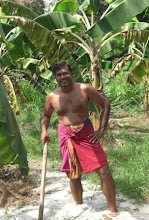
I spent the whole week at Ratmale in Polonnaruwa on my own as I have let go my driver due to straightened financial circumstances. Each day was an event in itself with unplanned events.
I had asked that a long chair a kavichchiya be woven in cane instead of cushioning it which is the preferred option in these parts, though weaving is the more appropriate course for this climate. I did not realize what a procedure that this simple task would become.
There is fake cane(plastic), called ‘Chintha’ which is about a quarter of the price of cane that people use, but which wont last very long, and then there is the real thing. For the particular piece of furniture the finest of the cane strips is required if the job is to be done to perfection. I require 3kg at a price of Rs1300/- a kg at the source.
Cutting cane is illegal, unless one has a permit. The plants are protected as endangered, as they grow along waterways and are seen less and less. I went with the weaver, who lives in the next village, the proud villages of Purana Ratmale(one of 7 original villages of Polonnaruwa) who call themselves high class Govigama, look down on these people as being transplanted recently as Rodiya. So they have to resort to skills other than farming.
It was a fair distance, to Manampitiya at the edge of the Polonnaruwa district crossing the mighty Mahaweli over the Japan Peace Bridge! There is cane right along the river banks and people here have permits to harvest and make the various sizes for the various woven products. I was given a lesson on the various qualities of cane by the owner of the shop, who also sells caneware and he told me that the Moratuwa furniture shops are his largest customers for cane for weaving in their workshops.
On the way back I stopped by my Hingurakgoda agricultural tract and this man spots the cane right along the river of my property, and tells me I have all the cane I want for any caneware and as long as I only use it for personal use it would not be a problem as I would encourage the growth of the plants by pruning mature cane and he would make anything I wanted on site. So this was an added bonus of the journey and meeting the weaver who explained how to preserve and why the shops in Wewaldeniya along the Kandy road sell nice looking cane ware which lasts only a short while because they are polished and ruin the longevity of the cane. He learnt his craft in Wewaldeniya, where the shops look enticing with prices less so.
Digressing a little I also purchased a reed mat, a super example of Thunhiriya reed, which he had made as a sample for a hotel, which wanted to use reed mats as the ceiling material. That hotel ordered 750 of these 6ft long mats for their entire ceiling.
Ironically, Ratmale used to be a center for the weaving of reed mats by the women primarily for home use but also as an additional income source. I have both Gallaha the superior version and Thunhiriya reed on my forest property. I am also in the process of preserving a Gallaha reed marsh on the property with the intention of having a weaver on site to make mats etc with this reed to maintain a fast dying craft in these areas.
It was therefore a pleasant if unexpected finding that I actually have the raw material for these crafts in my two Polonnaruwa properties both along wetlands and also know of local craftsman who can turn out items from them.


























